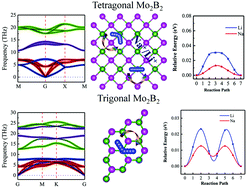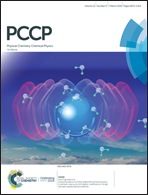Tetragonal and trigonal Mo2B2 monolayers: two new low-dimensional materials for Li-ion and Na-ion batteries†
Abstract
In this study, we report two new Mo2B2 monolayers and investigate their stabilities, electronic structures, lattice dynamics, and properties as anode materials for energy storage by using the crystal structure prediction technique and first-principles method. The calculated phonon spectra and electrical structures indicate that our predicted tetragonal and trigonal Mo2B2 (tetr- and tri-Mo2B2) monolayers possess excellent electronic conductivity and great stability. The adsorption energies of Li/Na on them are negative enough to ensure stability and safety under operating conditions. Besides, tetr-Mo2B2 possesses a theoretical specific capacity of ∼251 mA h g−1 for both Li- and Na-ion batteries (LIBs and NIBs), while tri-Mo2B2 possesses ∼251 and ∼188 mA h g−1 for LIBs and NIBs, respectively. The diffusion energy barriers of Li/Na over tetr- (0.029/0.010 eV) and tri- (0.023/0.013 eV) Mo2B2 are very small, indicating their excellent charge/discharge capability. In addition, the low electrode potential of Li/Na-intercalated tetr- and tri-Mo2B2 is beneficial to their performance as anode materials. This work is of great importance for widening the families of both anode materials for LIBs/NIBs and two-dimensional transition metal borides.



 Please wait while we load your content...
Please wait while we load your content...